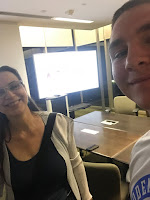drewpDESMA9

Week 4 Blog: Medicine + Technology + Art As professor Vesna discusses in her first lecture, human dissection was practiced during the Renaissance era in order to understand the human body on a much deeper and detailed level. During this time, doctors and artists were able to collaborate together in order to further their knowledge about the human body. The human anatomy has always been a fascinating subject to study and even today doctors are finding new methods to help benefit humanity in various ways. It has also helped us to understand life on a cellular/molecular level, giving us the basic building blocks of what us humans are built upon. Book explaining anatomy and dissection. Professor Vesna continues by saying how the evolution in technology has changed how we look at our own anatomy. X–rays, CAT scans, and M...


